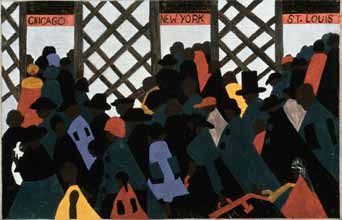|
|
 |
 |
 |
 During the World War there was a great migration North by Southern
Negroes.
During the World War there was a great migration North by Southern
Negroes.
The Migration of the Negro, panel
1, 1940-41. Casein tempera on hardboard, 12 x 18 in. (30.5 x 45.7 cm). The Phillips Collection, Washington, D.C.
Artwork © Gwendolyn Knight Lawrence, courtesy of the Jacob and Gwendolyn
Lawrence Foundation
Click here to view a larger image |
| |
|
 |
 indicates a link to another site
indicates a link to another site
After  Reconstruction
ended in 1876, the quality of life for Southern blacks severely deteriorated.
States adopted Reconstruction
ended in 1876, the quality of life for Southern blacks severely deteriorated.
States adopted  "Jim
Crow" laws, restricting the voting rights of African Americans
and requiring them to use separate public facilities. The "Jim
Crow" laws, restricting the voting rights of African Americans
and requiring them to use separate public facilities. The  Ku
Klux Klan and other racist groups terrorized blacks, forcing them
to live in fear of violence and lynching. Education facilities were
poor and work opportunities were limited. Economic problems included
boll weevil infestation of the cotton crops, land erosion brought
on by floods and drought, and a decline of cotton prices. Ku
Klux Klan and other racist groups terrorized blacks, forcing them
to live in fear of violence and lynching. Education facilities were
poor and work opportunities were limited. Economic problems included
boll weevil infestation of the cotton crops, land erosion brought
on by floods and drought, and a decline of cotton prices.
At this same time, the North was experiencing an economic boom. In
the early 1900s, northern mines and railroad businesses began to prosper,
increasing the demand for unskilled labor. Although European immigrants
initially filled these positions, during World War I, northern industry
turned to southern blacks as a source of cheap labor. Thousands of
blacks left the South in response to promises of a better life and
opportunities in the North. The majority of migrants traveled north
by rail.
This painting is the first one that Jacob Lawrence made about migration.
It shows a crowd of migrants about to embark on journeys to three
big cities. Lawrence painted the migrants without facial features.
Using a limited palette, Lawrence defined their clothing, hats, and
luggage as silhouetted shapes, enhancing a sense of collective action
as the crowd surges toward the station.
IMMIGRATION
Going from one's native land to a country in order to settle there
permanently.
MIGRATION
Moving from one country, region, or place to settle in another. |
|
|

• Go to  www.jacoblawrence.org,
scroll down to the "series" box and select The Migration of the
Negro, 1941 from the pull down menu. Click on SUBMIT. Look at all of the
train scenes in The Migration Series.
www.jacoblawrence.org,
scroll down to the "series" box and select The Migration of the
Negro, 1941 from the pull down menu. Click on SUBMIT. Look at all of the
train scenes in The Migration Series.
What similarities can you find?
What different points of view has Lawrence depicted?
Compare the different ways Lawrence uses color, shape, luggage, hats,
the train, and the train tracks in The Migration Series.
• Imagine that you are a migrant about to go on a journey to settle in a new
place.
How will you get there?
What will you take with you?
Make a list of things you would pack in a suitcase.
Print out the suitcase
drawing and draw your belongings inside. Draw your belongings as silhouette
shapes.
Next, design a label for the outside of your suitcase. Write the name of
the place where you are going on the label. Cut out the label and use a
glue stick to attach it to your suitcase. |









